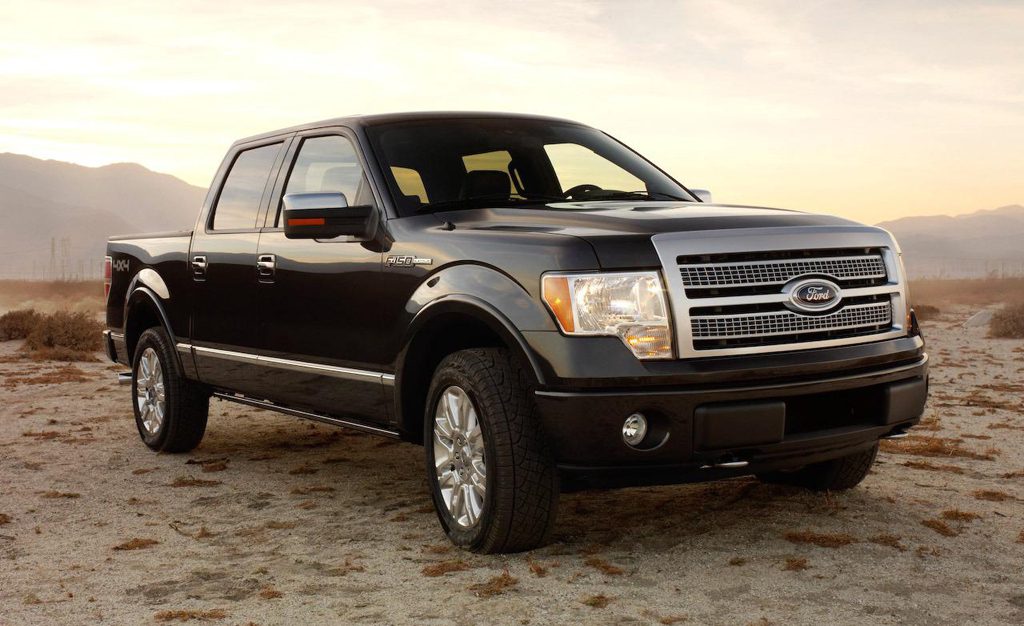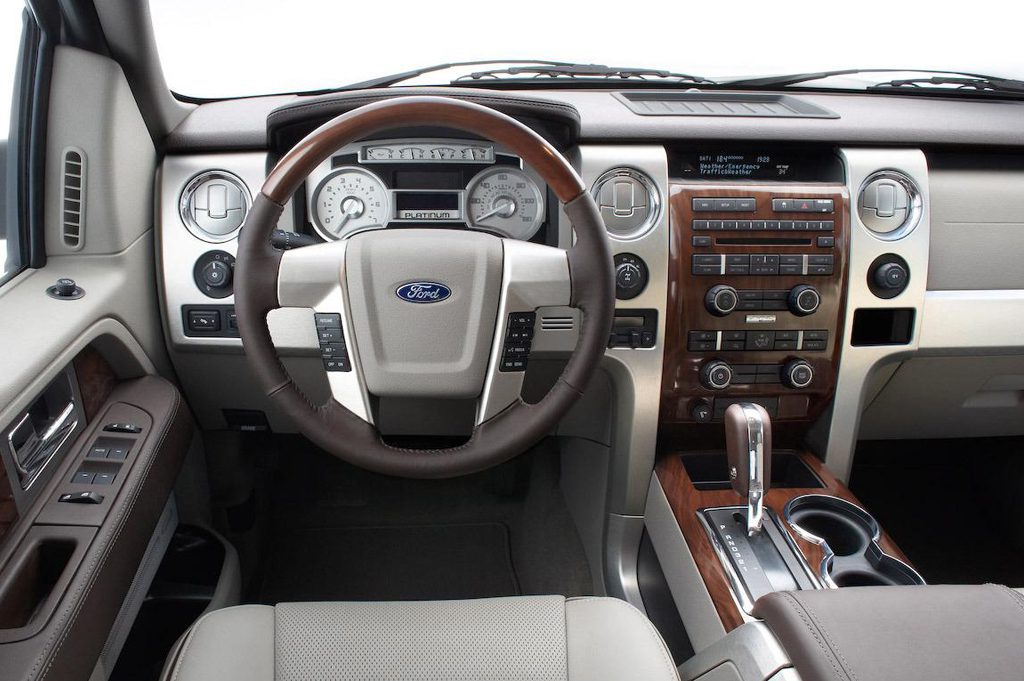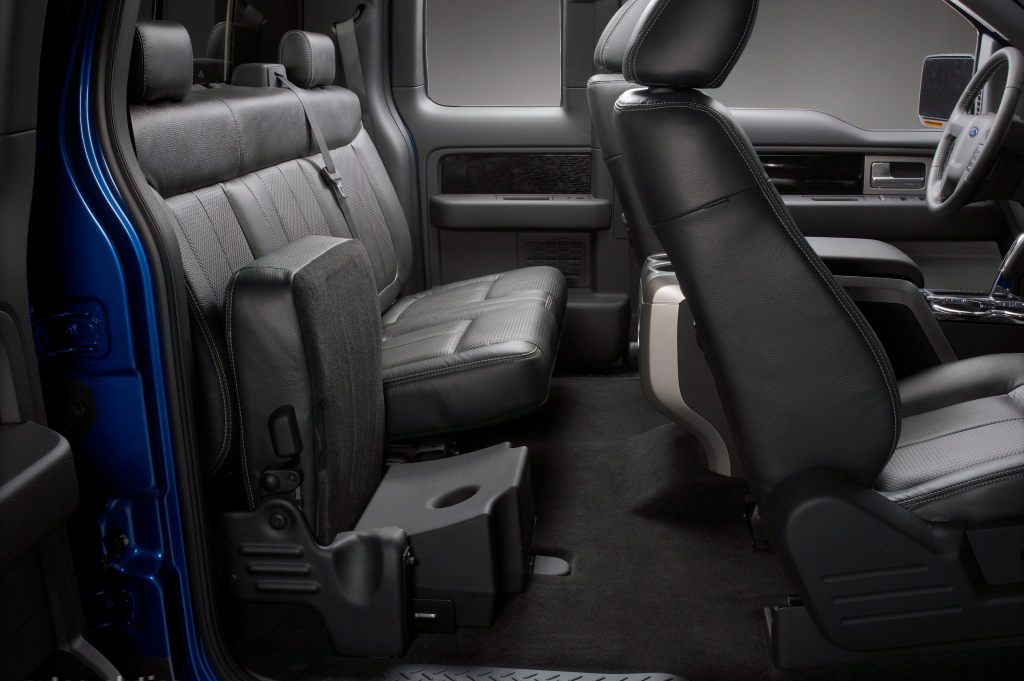| Optional Equipment |
| Option Note: |
| Major Packages |
| Option |
Avail. |
Retail |
Dealer |
| 101A Mid Equipment Group |
XL regular cab |
$2110 |
$1798 |
| Mfr. Disc. |
|
1360 |
1158 |
| 101A Mid Equipment Group |
XL SuperCab |
2310 |
1969 |
| Mfr. Disc. |
|
1560 |
1329 |
| 101A Mid Equipment Group |
XL SuperCrew |
1160 |
990 |
| Mfr. Disc. |
|
410 |
350 |
| Trailer Tow Pkg., MyKey parental control, cruise control, cloth upholstery, steering wheel radio controls, USB port, voice recognition, wireless cell-phone link, power mirrors (regular cab, SuperCab), power windows (regular cab, SuperCab), power door locks (regular cab, SuperCab), remote keyless entry (regular cab, SuperCab), AM/FM/CD/MP3 player, illuminated entry, alarm, chrome bumpers. |
| XL Decor Group |
XL |
115 |
97 |
| Cloth upholstery, driver lumbar adjustment, chrome bumpers. |
| Plus Pkg. |
XL |
450 |
385 |
| MyKey parental control, cruise control, AM/FM/CD/MP3 player, digital-media player connection. |
| Power Equipment Group |
XL regular cab |
950 |
811 |
| Power Equipment Group |
XL SuperCab |
1150 |
981 |
| Power mirrors, power windows, power door locks, remote keyless entry, alarm. Std. XL SuperCrew. |
| 201A Mid Equipment Group |
STX |
1885 |
1608 |
| Mfr. Disc. |
|
635 |
541 |
| Trailer Tow Pkg. plus steering wheel radio controls, USB port, voice recognition, wireless cell-phone link, stainless steel side steps, fog lights, P265/60R18 white-letter tires. |
| 301A Mid Equipment Group |
XLT |
1310 |
1116 |
| Mfr. Disc. |
|
810 |
690 |
| Trailer Tow Pkg. plus leather-wrapped steering wheel w/radio controls, 6-way power driver seat (SuperCab, SuperCrew), power-adjustable pedals, heated power mirrors w/turn signals, automatic day/night driver-side and rearview mirrors, satellite radio, trip computer, information screen. |
| 302A Luxury Equipment Group |
XLT |
4080 |
3478 |
| Mfr. Disc. |
|
3580 |
3052 |
| 301A Mid Equipment Group plus rear-obstacle-detection system, rearview camera, power-sliding rear window, rear defogger, unique exterior trim, chrome running boards, trailer-brake controller, P265/60R18 white-letter tires (2WD), P265/65R18 all-terrain white-letter tires (4WD), chrome alloy wheels. SuperCab 6.5-bed requires optional engine. NA regular cab. |
| Off-Road Pkg. |
XLT |
770 |
657 |
| Limited-slip differential, special axle ratio, hill-descent control, skid plates, off-road suspension. Requires Equipment Group, optional engine. |
| Chrome Pkg. |
XLT SuperCab/SuperCrew |
1595 |
1360 |
| Chrome exterior trim, chrome side steps, chrome front tow hooks (4WD), P265/60R18 white-letter tires (2WD), P275/65R18 all-terrain white-letter tires, chrome alloy wheels. Requires 301A Mid Equipment Group. NA 8-ft bed. |
| 401A Mid Equipment Group |
FX2, FX4 |
1350 |
1152 |
| Rear-obstacle-detection system, power-adjustable pedals, rearview camera, heated power mirrors w/turn signals and driver-side automatic day/night, power-sliding rear window, rear defogger, trailer-brake controller. |
| 402A Luxury Equipment Group |
FX2, FX4 |
5420 |
4621 |
| Mfr. Disc. |
|
4420 |
3768 |
| 401A Mid Equipment Group plus dual-zone automatic climate controls, leather upholstery, heated/cooled 10-way front seats, memory system (driver seat, mirrors, pedals), Sony sound system, high-definition radio, Sync services and assistance, 8-inch information screen, remote engine start, universal garage door opener, xenon headlights. |
| FX Appearance Pkg. |
FX2/FX4 w/401A Mid Equipment Group |
2480 |
2114 |
| FX Appearance Pkg. |
FX2/FX4 w/402A Luxury Equipment Group |
1780 |
1517 |
| Leather/synthetic-suede upholstery, unique interior and exterior trim, black side steps, P275/55R20 all-terrain white-letter tires. |
| 501A Mid Equipment Group |
Lariat |
1130 |
963 |
| Rear-obstacle-detection system, rearview camera, power-folding mirrors, universal garage door opener, remote engine start, trailer-brake control. |
| 501A Equipment Group Discount |
Lariat (credit) |
-500 |
-426 |
| Requires 501 Mid Equipment Group, navigation system, power sunroof. |
| 502A Luxury Equipment Group |
Lariat |
4920 |
4195 |
| Mfr. Disc. |
|
4170 |
3555 |
| 501A Mid Equipment Group plus navigation system, traffic information, tilt/telescopic steering wheel, front bucket seats, center console w/floor shifter, power sunroof, Sony sound system, high-definition radio, 110-volt power outlet, xenon headlights. |
| Off-Road Pkg. |
4WD Lariat/King Ranch |
770 |
657 |
| Limited-slip differential, special axle ratio, hill-descent control, skid plates, off-road suspension. Lariat requires Equipment Group. |
| Chrome Pkg. |
Lariat |
1495 |
1275 |
| Chrome mesh grille insert, chrome tubular running boards, chrome exhaust tip, chrome front tow hooks (4WD), chrome alloy wheels. Requires 501A Mid Equipment Group or 502A Luxury Equipment Group. |
| King Ranch Luxury Pkg. |
King Ranch |
2665 |
2272 |
| Mfr. Disc. |
|
2165 |
1846 |
| Navigation system w/voice recognition, traffic information, power sunroof, xenon headlights, tailgate step. |
| Chrome Pkg. |
King Ranch |
1250 |
1067 |
| Chrome exterior trim, chrome running boards, chrome exhaust tip, chrome front tow hooks (4WD), 20-inch chrome alloy wheels. Requires King Ranch Luxury Pkg. |
| 801A Luxury Equipment Group |
Raptor |
4760 |
4059 |
| Navigation system w/voice recognition, traffic information, rearview camera, Sync services and assistance, dual-zone automatic climate controls, power tilt/telescopic steering wheel, heated/cooled 10-way power front seats, power-adjustable pedals, memory system (driver seat, mirrors, pedals, steering wheel), heated and power folding mirrors w/turn signals and driver-side automatic day/night, Sony sound system, high-definition radio, universal garage door opener, remote engine start, xenon headlights, trailer-brake control. |
| Plus Pkg. |
Raptor |
595 |
507 |
| Rearview camera, trailer-brake controller. |
| Trailer Tow Pkg. |
XL, STX, XLT |
375 |
320 |
| Class IV trailer-hitch receiver, 7-pin wiring harness, heavy-duty radiator and battery, transmission-oil cooler. |
| Max Trailer Tow Pkg. |
XL/XLT 8-ft bed, XL/XLT SuperCrew 6.5-ft bed |
940 |
801 |
| Max Trailer Tow Pkg. |
FX2/FX4 w/401A Mid Equipment Group, Lariat w/501A Mid Equipment Group, King Ranch, Platinum |
460 |
393 |
| Max Trailer Tow Pkg. |
FX2/FX4 w/402A Luxury Equipment Group |
335 |
285 |
| Max Trailer Tow Pkg. |
Lariat |
795 |
678 |
| Trailer Tow Pkg. plus heated power trailer-tow mirrors, heavy-duty rear bumper, trailer-brake control. Requires EcoBoost 3.5-liter turbocharged V6 engine or 6.2-liter V8 engine. |
| Heavy-Duty Payload Pkg. |
XL regular cab/SuperCab 8-ft bed, XL SuperCrew 6.5-ft bed |
1500 |
1279 |
| Heavy-Duty Payload Pkg. |
XLT regular cab/SuperCab 8-ft bed, XLT/Lariat SuperCrew 6.5-ft bed |
1695 |
1445 |
| Flex-fuel 5.0-liter V8 engine, limited-slip differential, special axle ratio, heavy-duty radiator and transmission-oil cooler, 8200# GVWR, heavy-duty suspension, LT245/75R17E all-terrain tires, 7-lug steel wheels (XL), 7-lug alloy wheels (XLT). |
| Powertrain |
| Option |
Avail. |
Retail |
Dealer |
| EcoBoost 3.5-liter turbocharged V6 engine |
XL/XLT 3.7 V6 |
2095 |
1786 |
| EcoBoost 3.5-liter turbocharged V6 engine |
XL/XLT 5.0 V8, FX2, FX4, Lariat, King Ranch, Platinum |
1095 |
934 |
| NA XL/XLT regular cab 6.5-foot bed. |
| Flex-fuel 5.0-liter V8 engine |
regular cab, XL/STX/XLT SuperCab, 2WD XL/XLT SuperCrew 5.5-ft bed |
1000 |
853 |
| 6.2-liter V8 engine |
XLT, FX2, FX4, Lariat, Platinum |
2140 |
1824 |
| XLT, FX2, FX4 require Equipment Group. NA regular cab. |
| Limited-slip differential |
|
400 |
341 |
| Includes special axle ratio. Requires flex-fuel 5.0-liter V8 engine. Std. Lariat Limited. NA FX2, FX4, Raptor. |
| Locking differential |
|
470 |
401 |
| Requires flex-fuel 5.0-liter V8 engine. NA Raptor. |
| Special axle ratio |
|
50 |
44 |
| NA Limited, Raptor. |
| Comfort & Convenience Features |
| Option |
Avail. |
Retail |
Dealer |
| Navigation system |
FX2, FX4, Lariat, Platinum, King Ranch |
795 |
678 |
| Includes voice recognition, traffic information. FX2, FX4 require 402A Luxury Equipment Group. |
| Front-view camera |
Raptor |
525 |
448 |
| Requires 801A Luxury Equipment Group. |
| Telematics communications system |
XL, STX, XLT |
800 |
682 |
| Location, speed, and location tracking. Requires monthly fee. |
| Power sunroof |
FX2, FX4, Lariat, Platinum, King Ranch, Raptor |
995 |
848 |
| Raptor requires 801A Luxury Equipment Group. |
| Cloth upholstery |
XL |
0 |
0 |
| Includes driver-seat lumbar adjustment. |
| Front bucket seats |
4WD XL SuperCrew, XLT SuperCab, XLT SuperCrew |
300 |
256 |
| Includes center console. |
| Front bucket seats |
Lariat |
975 |
831 |
| Includes center console, floorshifter. Requires 501A Mid Equipment Group. |
| Leather upholstery |
Raptor |
750 |
640 |
| Requires 801A Luxury Equipment Group. |
| Sony sound system |
Lariat |
525 |
448 |
| Requires 501A Mid Equipment Group. |
| Power-sliding rear window |
XLT |
150 |
129 |
| Includes rear defogger. Requires 301A Mid Equipment Group. |
| Carpeting |
STX |
145 |
123 |
| Includes floormats. Requires 201A Mid Equipment Group. |
| Carpeting delete |
XLT |
0 |
0 |
| Vinyl floor covering. NA w/301A Mid Equipment Group. |
| Rubber floormats |
|
95 |
81 |
| STX requires carpeting. NA w/carpeting delete. NA XL, FX2, FX4, Raptor. |
| Appearance and Miscellaneous |
| Option |
Avail. |
Retail |
Dealer |
| Fog lights |
XL |
140 |
119 |
| Bug shield |
|
150 |
129 |
| NA FX2, Platinum, Limited, Raptor. |
| Cable lock |
|
120 |
103 |
| NA Platinum, Limited, Raptor. |
| Tailgate steps |
|
375 |
320 |
| XL, STX, XLT FX2, FX4, Lariat, King Ranch, Raptor require an Equipment Group. |
| Pickup box steps |
|
325 |
277 |
| XL requires 101A Mid Equipment Group. NA Raptor. NA 5.5-ft bed. |
| Tonneau cover |
|
495 |
422 |
| NA XL. |
| Drop-in bedliner |
|
350 |
243 |
| Spray-in bedliner |
|
475 |
405 |
| Wheelwell liner |
|
180 |
153 |
| NA XL. |
| Bed extender |
|
250 |
214 |
| Raptor requires 801A Luxury Equipment Group. NA XL, STX, XLT. |
| Tubular side steps |
XL regular cab/SuperCab |
300 |
256 |
| Bright tubular side steps |
XLT |
350 |
299 |
| Chrome tubular side steps |
XLT |
635 |
541 |
| NA regular cab. |
| Running boards |
XL SuperCrew |
250 |
214 |
| Running boards |
XLT SuperCab/SuperCrew |
325 |
277 |
| Running boards |
Lariat |
695 |
593 |
| Requires Equipment Group. |
| Bed-side graphics |
Raptor |
1075 |
916 |
| Hood graphics |
Raptor |
900 |
767 |
| 2-tone paint |
XLT, Lariat, Platinum |
250 |
214 |
| Single-tone paint |
King Ranch |
0 |
0 |
| Deletes std. 2-tone paint. Requires Chrome Pkg. |
| Special paint |
XLT, FX2, FX4, Lariat, Limited |
395 |
337 |
| Premium paint |
Lariat, King Ranch, Platinum, Limited, Raptor |
495 |
422 |
| Special Purpose, Wheels and Tires |
| Option |
Avail. |
Retail |
Dealer |
| Trailer-brake control |
XL, STX, XLT, FX2, FX4, Lariat |
230 |
196 |
| Requires Trailer Tow Pkg. Std. King Ranch, Platinum, Limited. |
| Skid plates |
4WD XL/Platinum |
160 |
137 |
| XL requires 101A Mid Equipment Group. Std. FX4, Raptor |
| P255/65R17 white-letter tires |
XL, XLT |
325 |
277 |
| XL requires 101A Mid Equipment Group. Std. SuperCrew. |
| P265/70R17 all-terrain white-letter tires |
XL/XLT SuperCab |
325 |
277 |
| 2WD requires Max Trailer Tow Pkg. XLT requires 301A Mid Equipment Group. |
| LT245/75R17E all-terrain tires |
4WD XLT |
300 |
256 |
| Requires Off-Road Pkg. NA regular cab. NA 8-ft bed. |
| P275/65R18 all-terrain white-letter tires |
XLT, FX2 |
275 |
234 |
| Requires Off-Road Pkg. or Chrome Pkg. |
| Alloy wheels |
XL |
375 |
320 |
| Bead-lock capable forged alloy wheels |
Raptor |
1165 |
994 |
| Requires 801A Luxury Equipment Group. |
| 20-inch alloy wheels |
Lariat |
795 |
678 |
| 20-inch alloy wheels |
FX2, FX4, King Ranch |
895 |
763 |
| Includes P275/55R20 white-letter tires (2WD), P275/55R20 all-terrain white-letter tires (4WD). FX2, FX4, Lariat require Equipment Group. |
| 20-inch chrome alloy wheels |
XLT, Lariat |
995 |
848 |
| Includes P275/55R20 white-letter tires (2WD), P275/55R20 all-terrain white-letter tires (4WD). Requires Equipment Group, Chrome Pkg. NA regular cab. |




